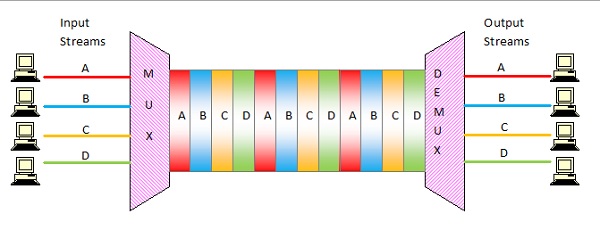
 Data Structure
Data Structure Networking
Networking RDBMS
RDBMS Operating System
Operating System Java
Java MS Excel
MS Excel iOS
iOS HTML
HTML CSS
CSS Android
Android Python
Python C Programming
C Programming C++
C++ C#
C# MongoDB
MongoDB MySQL
MySQL Javascript
Javascript PHP
PHP
- Selected Reading
- UPSC IAS Exams Notes
- Developer's Best Practices
- Questions and Answers
- Effective Resume Writing
- HR Interview Questions
- Computer Glossary
- Who is Who
Time Division Multiplexing
Frequency division multiplexing (FDM) is a technique of multiplexing, where the users are allowed the total available bandwidth on time sharing basis. Here the time domain is divided into several recurrent slots of fixed length, and each signal is allotted a time slot on a round-robin basis.
Concept and Process
In TDM, the data flow of each input stream is divided into units. One unit may be 1 bit, 1 byte, or a block of few bytes. Each input unit is allotted an input time slot. One input unit corresponds to one output unit and is allotted an output time slot. During transmission, one unit of each of the input streams is allotted one-time slot, periodically, in a sequence, on a rotational basis. This system is popularly called round-robin system.
Example
Consider a system having four input streams, A, B, C and D. Each of the data streams is divided into units which are allocated time slots in the round – robin manner. Hence, the time slot 1 is allotted to A, slot 2 is allotted to B, slot 3 is allotted to C, slot 4 is allotted to D, slot 5 is allocated to A again, and this goes on till the data in all the streams are transmitted.

Uses and Applications
It is widely used in telephone and cellular networks.
Statistical Time Division Multiplexing (STDM)
In STDM, the time slots are dynamically allocated to the slots according to demand. The multiplexer checks each input stream in a round – robin manner and allocates a slot to an input line only if data is present there, otherwise, it skips to the next stream and checks it.

